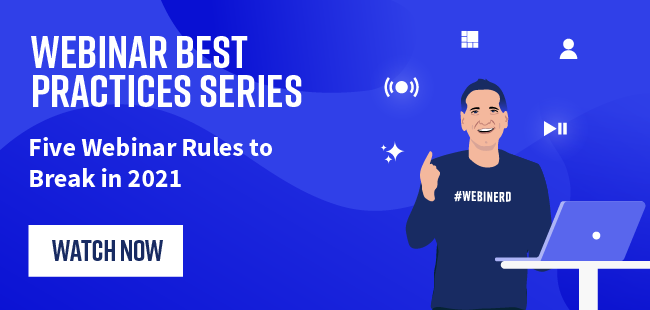Flipping the Webinar Script: 5 Rules to Break in 2021 and Beyond

Presenters like their scripts. They’re concise and assuring, and nowhere is this more apparent than when a host sticks the old rulebook and produces a webinar script. But sticking with the old rulebook could have you missing out on some novel opportunities to engage with your audiences.
Where we’re at vs. where we were one year ago

Much of 2020 was spent bridging the gap between the way things were and the way we needed them to be in order to stay connected with colleagues, customers and prospects while dispersed from the office.
But while we were forced almost overnight to deal with a new reality — both personally and professionally — we found ways to maintain genuine, human interaction in a digital world.
Digital transformations that would have taken months or years were activated in weeks, sometimes days. Many businesses quickly launched digital technologies that helped to reduce face-to-face interactions, safeguarding customer and employee health and well-being.
Now, more than a year in, businesses have begun to recognize the opportunities that come with a work-from-anywhere approach and are pivoting to reap the benefits.
We’re seeing a shift toward primarily digital interactions and experiences, from the day-to-day team meeting all the way up to virtual conferences, sales kickoffs, executive summits and more. And, it’s not showing any sign of slowing. In fact, according to Gartner research, 80% of B2B sales interactions will happen via digital channels by 2025.
Stop Doing Webinars the Old Way
It’s time to evolve your webinar marketing program. Let’s take a look at five generally accepted aspects of webinars and recommendations for how you can flip the script to build more authentic virtual experiences.
#1 Rule to break: Webinars should be delivered at the same date and time

Pre-pandemic, the best days for webinars were traditionally Tuesday, Wednesday and Thursday. But we saw a slight change in April 2020, with the tide shifting to Thursday and Friday, before shifting back to midweek.
Why this short-lived shift? Well, work habits changed.
Data has shown that remote employees in several countries are actually logging in more hours, and later in the day, than they did pre-COVID. So why shouldn’t their content consumption habits change as a part of this trend?
Today, the majority of our communications are conducted over virtual channels. When interacting with a screen for most of the day, there simply isn’t the time to view a webinar during normal business hours.
There is value in planning around the needs of our audiences, keeping in mind that they have other pulls on their schedules and attention: the demands of family, friends, pets, children, volunteering, exercise, etc.
Remember: Webinar Audiences Come First
Audiences today expect more from the content they consume. It needs to be available when they want it, should entertain and educate, give them control to participate and engage, and be presented in an approachable manner.
If you want to ensure your content is more likely to hit the mark, offer it up at times that are convenient for your audiences—whether live, simulive or on-demand. But, we’ll get to this in a bit.
Additional consideration: Webinar registrations are becoming more spontaneous!
It’s difficult to plan ahead when there are so many unknowns in your day/week/month and beyond. We saw this reflected in the timing of webinar registrations, with the percentage of those who waited until less than a week before an event to register jumping from 33% in 2019 to nearly 60% in 2020.
#2 Rule to break: Webinars are slide presentations

Repeat this one until it sticks: you don’t need a slide deck in order to run a successful webinar.
The presentation is not the webinar; it’s a tool. In fact, the most successful virtual events are those that create distinctive experiences where audiences can interact and gather knowledge, share learnings, ask questions and stay engaged — PowerPoint optional.
The world is a blank palette when it comes to your webinar marketing approach.
No slides, no problem! Reach out to a few subject matter experts and set up an organic, scriptless chat on a preferred topic. There doesn’t even have to be an agenda. Just keep the conversation rolling and make it engaging.
We’ve seen a number of examples of this over the last year, including but not limited to the following virtual experiences:
-
- Cocktails hours
- College campus tours
- Awards shows
- Branding events
- And more!
Successful approaches to each of the above share a number of components, including self-selective, interactive areas where attendees can ask questions, watch an additional video or connect to other virtual content.
When it comes to an agenda for your virtual event, try mixing things up a bit. For instance, you don’t need to wait until the end of your webinar to hold a Q&A. Why not open with one?
Real Webinars Are Engaging and Dynamic
Looking for other ways to engage your audience while running a live webinar? Ask for feedback throughout the event. Pepper in a little trivia on the subject matter, throw a poll out, or ask people what they’re interested in learning at the opening. Any one of these approaches is certain to keep your participants participating.
You don’t need to be a robot to deliver a good webinar. The most memorable moments can grow out of unforeseen, happy accidents. Just keep smiling and act like it was planned.
Overall, make sure to avoid verbose presentation decks read word-by-word. Just like storytime, you may put everyone to sleep.
#3 Rule To Break: Webinars must be live events

On-demand events can still be interactive. Whether live, simulive or on-demand, if you put the viewer in control of when they consume content, and provide the same interactive functionality as a live event, you will get them engaged.
With the right on-demand strategy, you can have your cake and eat it too. Host a live webcast, record it, and then convert to on-demand for live audiences to revisit, or for customers and prospects who were unable to attend to engage at their convenience. These on-demand assets are also great opportunities for content repurposing, allowing you to extend their reach across your site and other marketing channels.
Connect With Audiences On-Demand Anytime, Anywhere
Follow up with prospects to let them know when your webinar is available on demand. Then, promote your event via email, social media or other digital avenues, to drive additional registrations.
Use your events to create virtual environments to attract unique user groups, providing a continuous source of information, resources and community for tailored audiences.
Is it a space users will visit with frequency? Set up a subscription-based model for them to access the environment at their convenience. Some ideas on how to go about this below.
Create on-demand webinar hubs for a one-stop-shop on your latest and greatest, which you can:
-
- Embed on product pages or targeted landing pages
- Link to from digital conference pages
- Link to from other webinars
- Use as sales collateral in emails or other communications
Or, on-demand training experiences that allow visitors to:
-
- Self-select content options
- Access other webinars, videos, and PDFs
- Search for content by language
- Get topic-based content recommendations
- Watch live and on-demand
#4 Rule To Break: Webinars need to be a certain length of time

To be or not to be [snackable], that is the question.
This is a great one to A/B test the length of your virtual events as there’s no perfect answer. Sure, attention spans are shrinking, but the right content can keep modern audiences hooked for as long as you need them. Explore which types of virtual content perform best in a longer format vs. shorter, snackable bites.
It’s a myth that everything must be more easily digestible these days. Our data showed that the average webinar in 2020 was actually 56 minutes in length. In fact, you may find even greater success in hosting events that last multiple hours, or in some cases happen over the course of several days.
Experiment with Webinar Length
Find the right stride for your event type that takes into account audience schedules, prime times for consumption, and viewing habits.
If you notice that people only stick around for a few minutes into a longer webcast, chop it up into mini-casts and make the segments available as a curated playlist on a personalized landing page. Or, reformat the content as a series and email out new episodes each week to targeted audience groups.
#5 Rule to Break: Webinars should be gated to capture leads

This might be the most contentious point we raise here, and one that many of you will have difficulty taking up, but here it goes. You don’t need to capture leads from a webinar for it to be a profitable venture.
In fact, removing the form (or at least slimming it down considerably) from your landing pages will probably increase the reach of your content.
Ask yourself:
-
- Is the form keeping you from engaging with vital viewers?
- Can you simplify or remove fields for repeat customers?
- How will you engage with your audience post-event?
Why not gate new leads, then make your web marketing content no more than a button-click away for return customers? You don’t want to scare off regular visitors with a new form at every pass. What’s the point of developing a library of great content if no one ever gets through to see it?
Webinars Are About Engagement, Not Just Numbers
Instead, bring the entire buyer’s journey to your audiences in one interactive space. Create customized branding experiences with content selections that span the top, middle and bottom-of-funnel. Don’t forget to provide multiple opportunities for engagement, the ability to share content on social media and a clear call to action.
Stop focusing on lead generation. Get to know your audiences and you will find success in your content marketing approach.
Finding your webinar stride takes time, and experimentation!
The right webinar marketing strategy pushes past the boundaries of what we have come to expect and creates something that speaks to what we need.
Remember that it’s ok to break the rules. Rules are there sometimes specifically to be tested, to stretch our creative muscles and help us respond to change occurring around us.
So much of marketing can be dictated by rules, but they are merely guidelines to help us accomplish something, not the only way to go about it. Rules are not static—they evolve. And, that evolution is driven by rule breakers just like you.
Are you ready to seize the zeitgeist of the moment and embark on a journey that will refresh your content, reinvigorate your messaging and grab audiences where they are most likely to engage? Get to it, and don’t forget:
-
- Experiment with different days and times.
- Try new formats. Create experiences, not presentations.
- Test live, simulive and on-demand webinar strategies.
- Build webinars of every length for different purposes.
- Don’t count leads. Get to know people.
- And, BE HUMAN!

